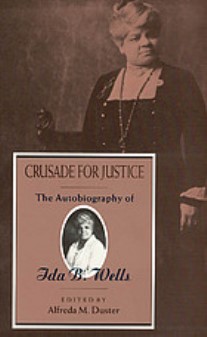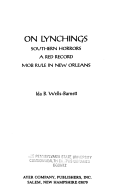What is the relationship between racial violence and capitalism? Today, this question is especially important given the racist police violence that has rocked the nation and weakened already-fragile black communities. From small suburban cities like Ferguson, Missouri, to big metropolitan centers like New York, black men and women have been brutally killed by law enforcement officers who have escaped punishment. In response, citizens have taken to the streets to protest, many carrying signs that read “Black Lives Matter” as a counter to the seeming disposability of black lives at the hands of law enforcement. This past summer, the frustration and rage that many black citizens felt was plastered across the news for weeks on end. It was not the long, hot summer of 1968. It was 2016.
Scholars, journalists, and concerned citizens have responded to the crisis in various ways, with different sides blaming each other for the loss of life and/or for the loss of material goods. However, much of the work has not properly interrogated the historical and contemporary dimensions of race and class. And even less of this work has examined the contributions of black women.
“Crusade for Justice provides a new way to think about black death and its relationship to modern capitalism and white supremacy.”In particular, Ida B. Wells’s groundbreaking analysis of lynchings at the end of the nineteenth century and early twentieth century chronicled in her autobiography, Crusade for Justice, and two pamphlets, Southern Horrors and The Red Record, has often gone under appreciated. Crusade for Justice provides a new way to think about black death and its relationship to modern capitalism and white supremacy. According to Wells, the logic of lynching was not criminal; it was economic. Lynching and mob violence were tactics of economic subordination, used to protect white economic power and to ensure a captive black labor force.
Wells and racial violence
Wells’ anti-lynching work began in 1892 while she was living in Memphis and editing Free Speech, a newspaper where she discussed controversial issues of local and national significance, even when harshly criticizing the African American and white communities. It was in this same year that racial tensions would climax over competition between an established white grocery store and the opening, across the street, of the African American–owned People’s Grocery Company in the African American section of town. The success of the People’s Grocery Company embittered a number of white residents who viewed its success as a threat to the racial power dynamics in Memphis. At the beginning of March, a group of whites, including law enforcement, pretended they were looking for criminals harbored at the People’s Grocery and violently attacked the store. Aware of the threat, the People’s Grocery had armed men who were keeping watch and they fired on the white men, wounding three and killing none. Surprised and frightened that African Americans had defended themselves, whites concocted a false story purporting law enforcement officers had been fired upon by blacks while carrying out their regular duties. As a result, over 100 African American men in Memphis were dragged from their homes and thrown into jail. On March 9, a mob of 75 white men disguised with black masks dragged three of Wells’s closest friends, who were the owners of the People’s Grocery Company, from jail and savagely lynched them in a railroad yard.1 Chicago: The University of Chicago Press, 1970More Info →
Chicago: The University of Chicago Press, 1970More Info →
The lynchings of her three friends marked a transformative moment in Wells’s life. The lynchings created numerous unanswered questions for Wells since they were contrary to the accepted belief that lynchings were punishment for rape. But her three friends were not charged with that crime. If lynchings were not always the response to rape, what other reasons existed for lynching African Americans? Wells’s inquiry led her to conclude that concerns about economic competition between the white grocer and her friends’ grocery store were the real reason behind the brutal lynching. After the lynching, Wells conveys their economic underpinnings:
“The mob took possession of the People’s Grocery Company, helping themselves to food and drink, and destroyed what they could not eat or steal. The creditors had the place closed and a few days later what remained of the stock was sold at an auction. Thus, with the aid of the city and county authorities and the daily papers, that white grocer had indeed put an end to this rival Negro grocer as well as to his business.”2
Chicago: The University of Chicago Press, 1970More Info →
For Wells, lynching was intricately linked to the protection of white economic power. It was an unofficial tool of the state to thwart black economic advancement.
Understanding lynching as a tool of state economic repression, Wells encouraged black residents of Memphis to leave, taking with them their labor and capital. The departure of many African American residents had a profound impact on the economics of Memphis. After six weeks of lagging revenue, the local white-owned railway company approached Wells to ask for her support to get blacks to ride the streetcars again. In the following exchange with the railway company, Wells argues that nineteenth-century capitalism depended on racial violence:
“‘Why, it was just six weeks ago that the lynching took place.’ [Wells said.] ‘But the streetcar company had nothing to do with the lynching,’ said one of the men. ‘It is owned by northern capitalists.’
‘And run by southern lynchers,’ I retorted. ‘We have learned that every white man of any standing in town knew of the plan and consented of the lynching of our boys.’”3Chicago: The University of Chicago Press, 1970More Info →
Worried about being left behind in the industrial revolution taking place in the North, whites in the post-Reconstruction South needed cheap labor and deeply resented economic competition from African Americans. Wells’s writings reveal it was this volatile mix that fueled the increase of lynchings and mob violence.
“Lynching, she determined, was “an excuse to get rid of Negroes who were acquiring wealth and property and thus keep the race terrorized and ‘keep the nigger down.’”Despite threats on her life in Memphis due to her activism and reporting, Wells was convinced a lot of power lay in the media and moved to New York where she continued writing: this time for T. Thomas Fortune’s New York Age, an African American weekly newspaper with a substantial white following. For her first article, Wells drew on the full extent of the material collected from her lynching investigations. On June 25, 1892, it became the first published exposé of lynching in the United States. Wells reported on facts she gathered, giving names, dates, and places of many lynchings for the accused crime of rape. The New York Age placed the article on its front page, printed 10,000 copies, and distributed them across the country. Wells’s facts made clear lynching was not a response to rape or to a greater level of criminality among African Americans. Lynching, she determined, was “an excuse to get rid of Negroes who were acquiring wealth and property and thus keep the race terrorized and ‘keep the nigger down.’”4 Chicago: The University of Chicago Press, 1970More Info →
Chicago: The University of Chicago Press, 1970More Info →
Wells’s work in exploding the lynching myth is noteworthy for it attacked the foundation of white supremacy. During this time, the most common justification for lynching was the racist rape myth of white women by African American men. The myth became reality for many because of its constant repetition by state and city politicians, pastors, and reporters in the white press. Wells, through her investigations, told another story: lynching was used to maintain the total—economic, educational, social—subordination of African Americans. The resulting conclusion was not hard to draw that, if lynching was not a response to African American criminality but instead a tool to maintain white economic power, then it was unjust.5 Chicago: The University of Chicago Press, 1970More Info →
Chicago: The University of Chicago Press, 1970More Info →
Never before had anyone questioned the veracity of lynching justifications with such authority. This was groundbreaking, since a majority of African Americans and whites accepted the mythologized explanation. The great abolitionist Frederick Douglass visited Wells and applauded her for this revelation, as Douglass had been misled into believing the myth and assumed lynching was a response to increases in African American criminal activity.6 Chicago: The University of Chicago Press, 1970More Info → Even white northerners had become desensitized to the lynching of African Americans. Writing about the sentiments of whites regarding lynching, Mary White Ovington, a white suffragette, settlement worker, and future founder of the NAACP observed, “New Yorkers were not interested in anti-lynching. Nearly all believed that, when a Negro was lynched, it was for the crime of rape, and, while mob violence was wrong, it was easily excused.”7 Mary White Ovington, “Early Years of the NAACP and the Urban League,” Baltimore Afro-American, December 10, 1932.
Chicago: The University of Chicago Press, 1970More Info → Even white northerners had become desensitized to the lynching of African Americans. Writing about the sentiments of whites regarding lynching, Mary White Ovington, a white suffragette, settlement worker, and future founder of the NAACP observed, “New Yorkers were not interested in anti-lynching. Nearly all believed that, when a Negro was lynched, it was for the crime of rape, and, while mob violence was wrong, it was easily excused.”7 Mary White Ovington, “Early Years of the NAACP and the Urban League,” Baltimore Afro-American, December 10, 1932.
Wells’s legacy
As a result of the publishing of Wells’s findings, $500 was raised for Wells to publish her New York Age article into a pamphlet retitled Southern Horrors: Lynch Law in All Its Phases in 1892. Not long afterwards, in 1895, Wells published a more ambitious project, The Red Record. Similar to her first pamphlet but on a larger scale, Wells provided details of lynchings including the victims’ names, dates, location, and alleged motives. The Red Record was an account of the research on lynchings she conducted between 1892 and 1894 across the country. The book also included narratives and lynching photographs. The pamphlets were useful in dispelling the rape myth, as they established a clear pattern of using lynchings in the service of white supremacy.8 New York: Arno Press, 1969More Info →
New York: Arno Press, 1969More Info →
Wells’s radical inquiry into lynching had a profound effect on the future of civil rights in the United States. Wells is responsible for a number of extraordinary “firsts” in the effort to rid America of lynchings. She was the first person to risk her life, time after time, while conducting dangerous lynching investigations. Wells was the first American to travel abroad to seek international support in the fight against lynchings. She also wrote the first article and pamphlet exposing the economic underpinnings of lynching. Finally, and perhaps most importantly, Wells was the first to effectively situate lynching at the crux of American democracy: in order to protect the voting, education, and workplace rights of African Americans, their senseless killings had to stop.
The relevance of Wells today
To be clear, this is not a book that explicitly takes up capitalism in the way other texts do on Items; Crusade for Justice is a text about Ida B. Wells’s lifelong commitment to protecting black lives and exposing lynching as a tool of white supremacy. What becomes immediately clear, and the reason I think it belongs on the shelf of classics on racial justice, is its recovery of radical inquiry. Wells risked her life to intervene in a widely accepted narrative of white supremacy and black criminality. Her revelation that the issue at stake was not rape but often black economic success was paradigm shifting.
“Racial violence was a means to keep blacks in their place and stymie their economic advancement.”Reading Crusade for Justice today helps us understand that racial violence is often linked to shifts in the accumulation of capital away from non-whites. According to Wells, once you got past the smoke and mirrors of empty state justifications like “rape,” there was often an underlying economic reason behind the lynching that was tied to labor competition, wages, or work. Economic success—not criminal wrongdoing—explained why many blacks were lynched. In this formulation, racial violence was a means to keep blacks in their place and stymie their economic advancement. The most obvious example is the Tulsa Race Massacre of 1921 that decimated what was often referred to as “black Wall Street”—one of the most affluent black communities in the United States.
Today, the relationship between economics and racial violence still exists. For example, the Department of Justice (DOJ) completed a review of the Ferguson Police Department that revealed the police routinely harass black residents and exploit them as a source of revenue. “Many officers appear to see some residents, especially those who live in Ferguson’s predominately African American neighborhoods, less as constituents to be protected than as potential offenders and sources of revenue,” the report concluded. It found the disproportionate number of arrests, tickets, and use of force stemmed from “unlawful bias” rather than black people committing more crime. The DOJ report on Ferguson was met with widespread condemnation and surprise by the larger public. But, if we take the lessons from Wells seriously, we must always pay close attention to the dialectical relationship between anti-black violence and the accumulation of capital.














Comments are closed.